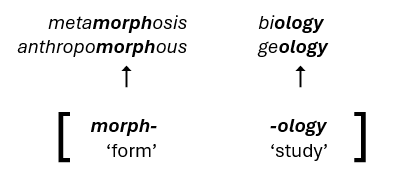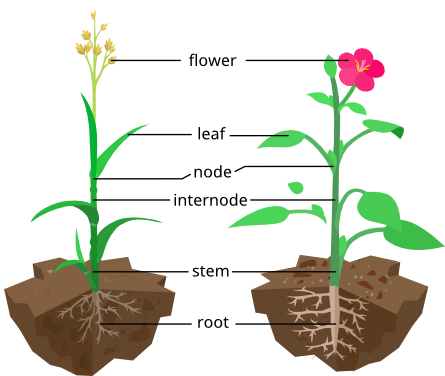Section 5.1 A first look at morphology
If this is the first time that you encounter the word morphology, how come you nonetheless have a rough idea of what it may mean? You are sure to recognize the element ‑(o)logy from words like biology, zoology or geology, which are fields of study or disciplines, so you know that morphology is likely a field of study (presumably, since you are reading a linguistics textbook, a subfield of linguistics). If you happen to know words like metamorphosis or anthropomorphous, you might also be able to guess that the element morph‑ has something to do with shape or form, so you know that morphology is probably the study of the form of something.
In making these guesses, you have already conducted a morphological analysis: You have dissected a word into smaller elements and made connections to other words you know that contain the same elements (see Figure 5.1.1).

The word “morphology” in square brackets, split into the morphemes “morph” (meaning form) and “ology” (meaning the study of). An arrow is pointing from “morph” to the same morpheme “morph” in the words “metamorphosis” and “anthropomorphous”. Another arrow is pointing from “ology” to the same morpheme in the words “biology” and “geology”.
Indeed, morphology is a general term for the study of forms in many disciplines. It originates in biology, where it refers to “the comparison of the forms of organisms and their parts in order to identify homologous structures” (OED, s.v. morphology), and was adapted (in that order) into linguistics, geology and other disciplines. Figure 5.1.2 shows an example of (very simple) plant morphology (note that some of the specific terms for parts of plants were also borrowed into linguistics, you will encounter them in this and the next chapter)!

a diagram of two flowering plants with various parts labeled, from top to bottom: flower, leaf, node, internode, stem, and root
In linguistics, too, morphology refers to the study of homologous structures, in this case, of words. Morphology is the study of words and their internal structure. The basic unit of morphological analysis is the morpheme, the smallest meaningful unit of language. The word /mɔɹˈfɑ.lə.dʒi/ morphology, as we have seen, consists of two morphemes, {/mɔɹf/} ’shape, form’ and {/ɑ.lə.dʒi/} ’study, discipline’. These are the smallest meaningful units contained in the word — if you break them up further, you lose the meaning: /mɔ/, /ɔɹf/ or /dʒi/, for example, do not mean anything. Of course, /ɔɹ/ or and /lədʒ/ ledge mean something, but that is an accidental similarity: the meaning of the words or and ledge does not figure in the meaning of the word morphology.
Words that consist of one morpheme, like the word plant, are called simple or monomorphemic words. Words that consist of more than one morpheme, like the word morphology, are called complex or polymorphemic words. Note that there is no direct relationship between morphemes and syllables: morphemes can be larger or smaller than syllables. The simple word plant consists of one syllable, the simple word flower consists of two syllables. The complex word flowers, which consists of the morphemes {flower} and {‑s}, also has two syllables, just like the singular flower, so the plural morpheme {‑s} is smaller than a syllable. Thus, do not confuse the two: syllables are meaningless elements of phonological structure, morphemes are meaningful signs (remember the discussion of two levels of organization in Section 2.4).
Note that we represent morphemes in curly braces, giving either their phonemic form or (if their phonological structure is obvious or plays no role in the analysis), in the standard orthography (in italics, as always). If we need to show their meaning, we will do so (for now) by giving it in single quotation marks after the morpheme, according to the convention introduced in Section 2.1.
Subsection
CC-BY-NC-SA 4.0. Written by Kirsten Middeke, with editing by Anatol Stefanowitsch.
